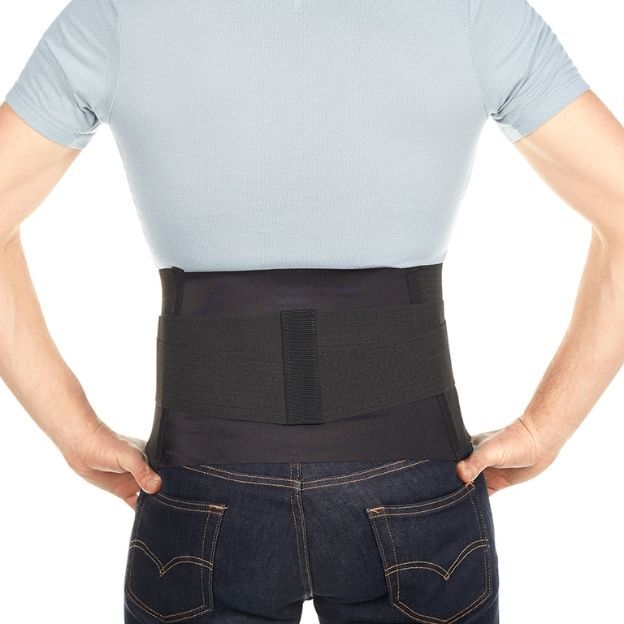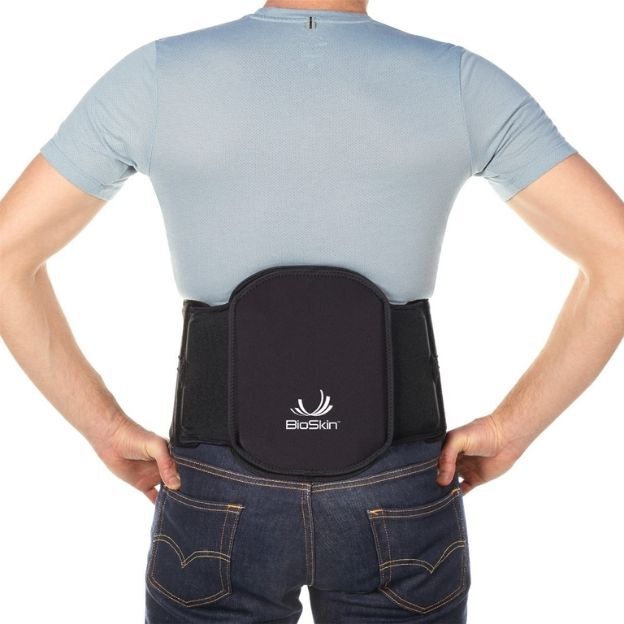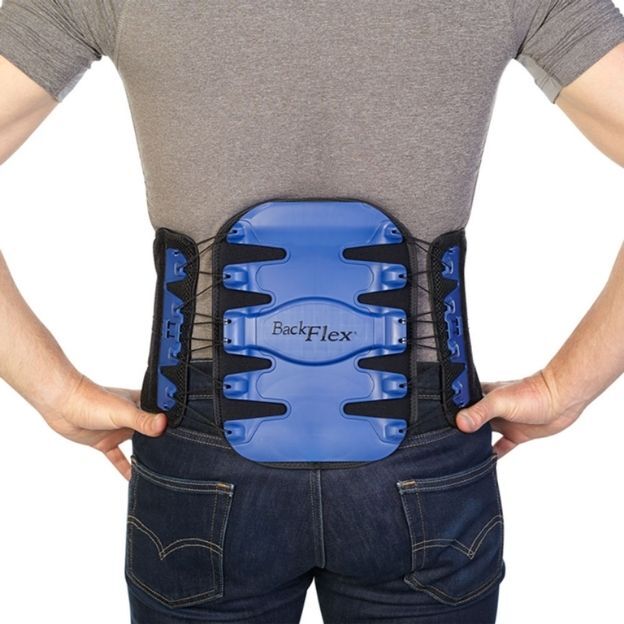A back brace for pain relief should feel like a light, helpful layer, not a bulky shell, adding targeted compression and simple structure so everyday movement is easier.
A back brace offers support that helps you do the work: move more comfortably, follow your rehab, and sit or stand with better alignment.
Fast Self-Check: What You Feel and When You Feel It
Use these patterns to choose simple, accurate support—then confirm fit with your clinician if you’re unsure.
“Hurts with sitting > 30 min.”
- Likely posture/pressure sensitivity from long flexed positions.
- Try: a low-profile compression sleeve or flexible lumbar belt with a small pad for targeted support. Aim for gentle lumbar support that reminds you to stack ribs over pelvis; take micro-breaks every 30–45 minutes.
“Lifting/yardwork sets it off.”
- Discomfort during higher load or awkward reaches.
- Try: an adjustable lumbar wrap with tension straps you can tighten for the task and loosen after, or a semi-rigid brace (flexible stays, no bulky shells) for short bouts of extra support. Wear it for the activity and not all day.
“Morning stiffness, better as the day goes on.”
- Common after overnight immobility.
- Try: light, gentle compression from a sleeve in order to warm tissues and reduce muscle tension for the first hours, then wean to no brace as movement improves.
“Standing/walking triggers ache.”
- Prolonged upright time can fatigue the back and hips.
- Try: an adjustable lumbar belt for subtle abdominal compression and posture cues; if you still feel wobbly, step up to a semi-rigid option with slim stays for “stand/walk” windows, then remove during rest.
Low-Bulk Options, From Lightest to Most Control
If you want real back pain relief without heavy hardware, focus on designs that stay slim, breathable, and easy to adjust.
Compression sleeve (lowest profile) – BioSkin Lumbar Back Support

Made from thin, breathable mesh, this soft brace provides consistent compression to reduce pain, ease sore muscles, and support injury recovery during daily activity.
- Does: deliver light, comfortable pressure for lower back pain relief and mild posture cues.
- Doesn’t: offer the structured control needed for significant instability or post-surgical recovery.
Adjustable lumbar wrap – BioSkin Vector Lumbar Support

A slim, flexible brace with a dual-pulley system and removable pad that allows quick tension changes throughout the day.
- Does: give targeted support to ease tense muscles and improve spinal alignment during activity.
- Doesn’t: replace higher-control designs for chronic or severe pain that needs added motion control.
Semi-rigid, still-low-profile brace – BioSkin Back Flex Lumbar Brace

This option blends flexibility with molded front panels and vectored straps for semi-rigid stability—ideal when you want structure without heavy shells.
- Does: promote improved posture, support recovery from back injuries, and provide extra control when movement feels unstable.
- Doesn’t: fully immobilize; conditions like a compression fracture or herniated disc still need evaluation from a qualified health professional before selecting a brace.
Fit That Feels Invisible (And Works)
Getting size and setup right matters more than any feature; a well-fitted brace should disappear into your routine while still giving steady support. Use this quick guide before you wear it for a full day.
How to measure
Use the product’s size chart and measure at the level it specifies (often around the natural waist/abdomen). Stand relaxed, keep the tape level and parallel to the floor, and pull it snug (not tight). Take two readings and use the average.
If you’re between sizes, choose the fit that suits your day: slightly closer for more compression, or the next size up for easier all-day wear.
Snug vs. tight
Snug means you can breathe, walk, and sit normally. Too tight feels like pinching or digging and can cause numbness, tingling, or sharp pressure points, especially when you bend. If that happens, loosen the straps, re-center the pad, or move up a size.
Layering
For the best grip and lowest bulk, wear the brace directly on the skin. If you prefer a barrier, use a thin, smooth base layer (no seams under the pad) and avoid thick or slick fabrics that make the brace slide. Recheck strap tension after a few minutes—materials settle, and a small adjustment restores that “invisible” feel.
Pair the Brace With Small Habits That Matter
A back brace for pain relief works best when it complements movement, not replaces it. Gentle, regular activity helps maintain core muscle engagement, improves circulation, and prevents stiffness from extended wear. The following are evidence-supported, low-risk habits most clinicians encourage (confirm with your own provider if you’re under specific restrictions).
Two-minute micro-break
Every 30–45 minutes, stand, align your ribs over your pelvis, and perform a gentle hip hinge—pushing your hips back slightly while keeping the spine neutral. This helps counteract poor posture and reduces stiffness from sitting or standing still for too long.
Core basics
Even simple movements matter. Try three foundation exercises often cleared for people with mild lower back pain:
- Abdominal brace: Tighten your abdominal wall gently as if bracing for a cough—no movement needed.
- Glute set: Squeeze glutes while standing, hold for 5 seconds, then release.
- Supported hinge: Hands on a counter or chair, hinge at the hips, then return upright.
Each move helps keep core muscles active while avoiding painful movements or strain.
Heat/cold timing (if your brace allows a pack)
Use heat before activity or in the morning to ease stiffness and reduce pain from tense muscles. Use cold after strenuous activity or a flare-up to calm soreness and limit swelling. Apply 15–20 minutes at a time, using a thin layer between skin and pack.
These practices are widely supported in clinical guidelines for chronic pain management and lower back pain relief, including recommendations from the American Physical Therapy Association (APTA) and Mayo Clinic. They’re designed to promote healing, prevent muscle deconditioning, and improve comfort during brace use.
Find Your BioSkin fit
Our back braces are designed for real-world comfort and reliable support—thin, breathable, and easy to wear under clothing without bulk.
Choose the level that fits your routine: the Lumbar Back Support for everyday compression and comfort, the Vector Lumbar Support for adjustable tension during activity, or the Back Flex Lumbar Brace for structured stability with molded panels and targeted compression. Each delivers unparalleled support.
Explore our collection to find the right brace for how you move, recover, and work.
Frequently Asked Questions
How does lumbar support in a low-profile brace help with back pain relief?
Targeted compression and gentle posture cues can reduce muscle tension and make daily movement more comfortable; it’s supportive, not a cure, and works best alongside activity and clinician guidance if symptoms persist.
What’s the difference between a brace for the lower back and rigid orthoses?
A low-profile brace offers flexible support for everyday tasks, while rigid orthoses use firm panels/uprights for higher motion control and are typically used under medical direction for specific conditions.
Does a back brace for the lower back with a removable pad make a difference?
Yes, placing the pad over sore or fatigued areas can add focused pressure for comfort during activity; remove or reposition it if it feels intrusive or increases soreness.
Can back support help after back injuries and still allow lower back pain relief?
It can provide short-term stability and comfort so you can move more confidently, but it doesn’t replace rehab or medical care; see a clinician for red flags (numbness, weakness, bowel/bladder changes) or persistent pain.


 US Dollars
US Dollars
